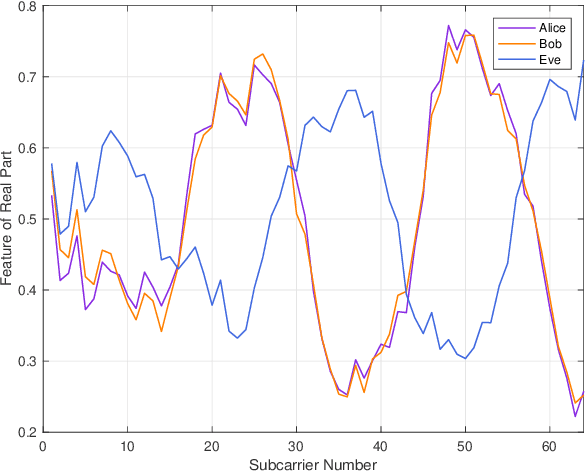Guyue Li
Coding-Enhanced Cooperative Jamming for Secret Communication in Fluid Antenna Systems
Jul 02, 2024Abstract:This letter investigates the secret communication problem for a fluid antenna system (FAS)-assisted wiretap channel, where the legitimate transmitter transmits an information-bearing signal to the legitimate receiver, and at the same time, transmits a jamming signal to interfere with the eavesdropper (Eve). Unlike the conventional jamming scheme, which usually transmits Gaussian noise that interferes not only with Eve but also with the legitimate receiver, in this letter, we consider that encoded codewords are transmitted to jam Eve. Then, by employing appropriate coding schemes, the legitimate receiver can successfully decode the jamming signal and then cancel the interference, while Eve cannot, even if it knows the codebooks. We aim to maximize the secrecy rate through port selection and power control. Although the problem is non-convex, we show that the optimal solution can be found. Simulation results show that by using the FAS technique and the proposed jamming scheme, the secrecy rate of the system can be significantly increased.
Two-Factor Authentication Approach Based on Behavior Patterns for Defeating Puppet Attacks
Nov 17, 2023Abstract:Fingerprint traits are widely recognized for their unique qualities and security benefits. Despite their extensive use, fingerprint features can be vulnerable to puppet attacks, where attackers manipulate a reluctant but genuine user into completing the authentication process. Defending against such attacks is challenging due to the coexistence of a legitimate identity and an illegitimate intent. In this paper, we propose PUPGUARD, a solution designed to guard against puppet attacks. This method is based on user behavioral patterns, specifically, the user needs to press the capture device twice successively with different fingers during the authentication process. PUPGUARD leverages both the image features of fingerprints and the timing characteristics of the pressing intervals to establish two-factor authentication. More specifically, after extracting image features and timing characteristics, and performing feature selection on the image features, PUPGUARD fuses these two features into a one-dimensional feature vector, and feeds it into a one-class classifier to obtain the classification result. This two-factor authentication method emphasizes dynamic behavioral patterns during the authentication process, thereby enhancing security against puppet attacks. To assess PUPGUARD's effectiveness, we conducted experiments on datasets collected from 31 subjects, including image features and timing characteristics. Our experimental results demonstrate that PUPGUARD achieves an impressive accuracy rate of 97.87% and a remarkably low false positive rate (FPR) of 1.89%. Furthermore, we conducted comparative experiments to validate the superiority of combining image features and timing characteristics within PUPGUARD for enhancing resistance against puppet attacks.
Enabling Deep Learning-based Physical-layer Secret Key Generation for FDD-OFDM Systems in Multi-Environments
Nov 06, 2022Abstract:Deep learning-based physical-layer secret key generation (PKG) has been used to overcome the imperfect uplink/downlink channel reciprocity in frequency division duplexing (FDD) orthogonal frequency division multiplexing (OFDM) systems. However, existing efforts have focused on key generation for users in a specific environment where the training samples and test samples obey the same distribution, which is unrealistic for real world applications. This paper formulates the PKG problem in multiple environments as a learning-based problem by learning the knowledge such as data and models from known environments to generate keys quickly and efficiently in multiple new environments. Specifically, we propose deep transfer learning (DTL) and meta-learning-based channel feature mapping algorithms for key generation. The two algorithms use different training methods to pre-train the model in the known environments, and then quickly adapt and deploy the model to new environments. Simulation results show that compared with the methods without adaptation, the DTL and meta-learning algorithms both can improve the performance of generated keys. In addition, the complexity analysis shows that the meta-learning algorithm can achieve better performance than the DTL algorithm with less time, lower CPU and GPU resources.
Deep Learning-based Physical-Layer Secret Key Generation for FDD Systems
May 18, 2021



Abstract:Physical-layer key generation (PKG) establishes cryptographic keys from highly correlated measurements of wireless channels, which relies on reciprocal channel characteristics between uplink and downlink, is a promising wireless security technique for Internet of Things (IoT). However, it is challenging to extract common features in frequency division duplexing (FDD) systems as uplink and downlink transmissions operate at different frequency bands whose channel frequency responses are not reciprocal any more. Existing PKG methods for FDD systems have many limitations, i.e., high overhead and security problems. This paper proposes a novel PKG scheme that uses the feature mapping function between different frequency bands obtained by deep learning to make two users generate highly similar channel features in FDD systems. In particular, this is the first time to apply deep learning for PKG in FDD systems. We first prove the existence of the band feature mapping function for a given environment and a feedforward network with a single hidden layer can approximate the mapping function. Then a Key Generation neural Network (KGNet) is proposed for reciprocal channel feature construction, and a key generation scheme based on the KGNet is also proposed. Numerical results verify the excellent performance of the KGNet-based key generation scheme in terms of randomness, key generation ratio, and key error rate, which proves that it is feasible to generate keys for FDD systems with lower overhead and more secure functions compared to existing methods.
 Add to Chrome
Add to Chrome Add to Firefox
Add to Firefox Add to Edge
Add to Edge